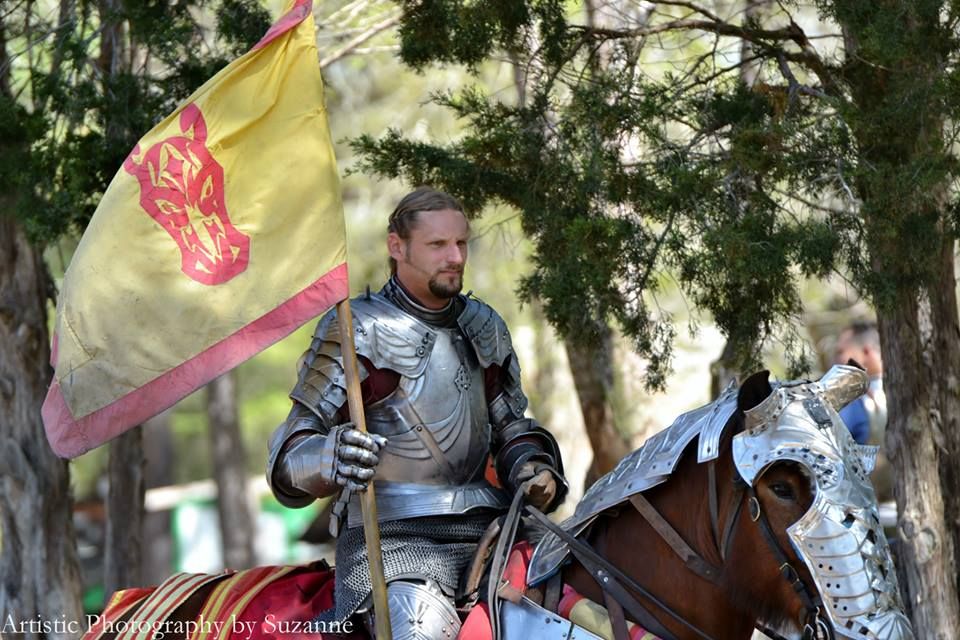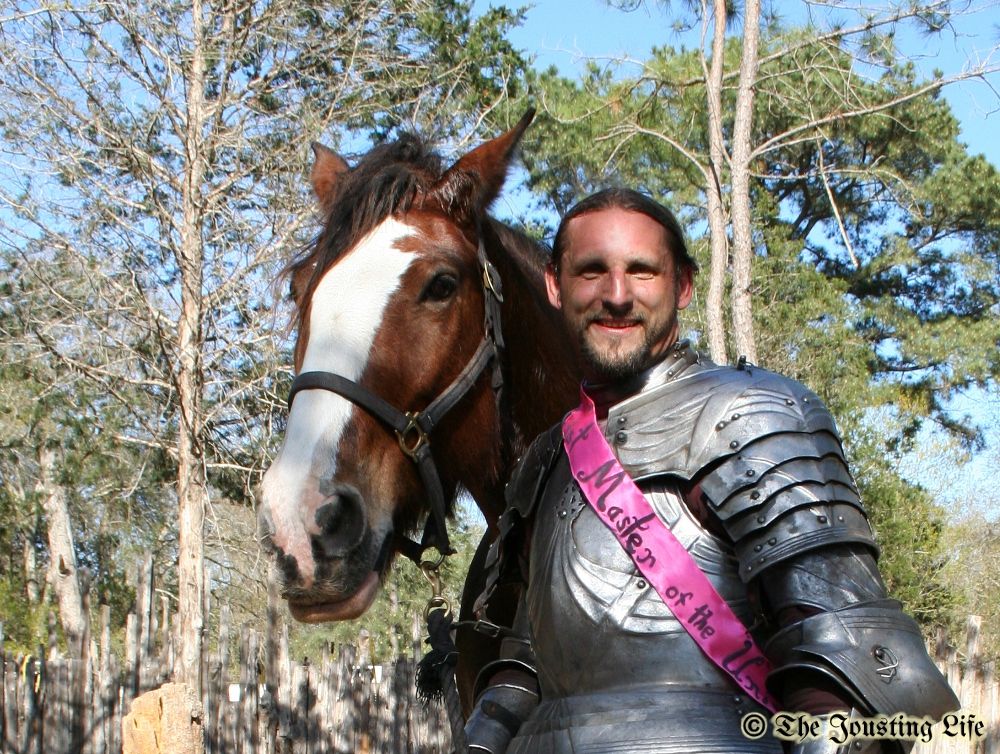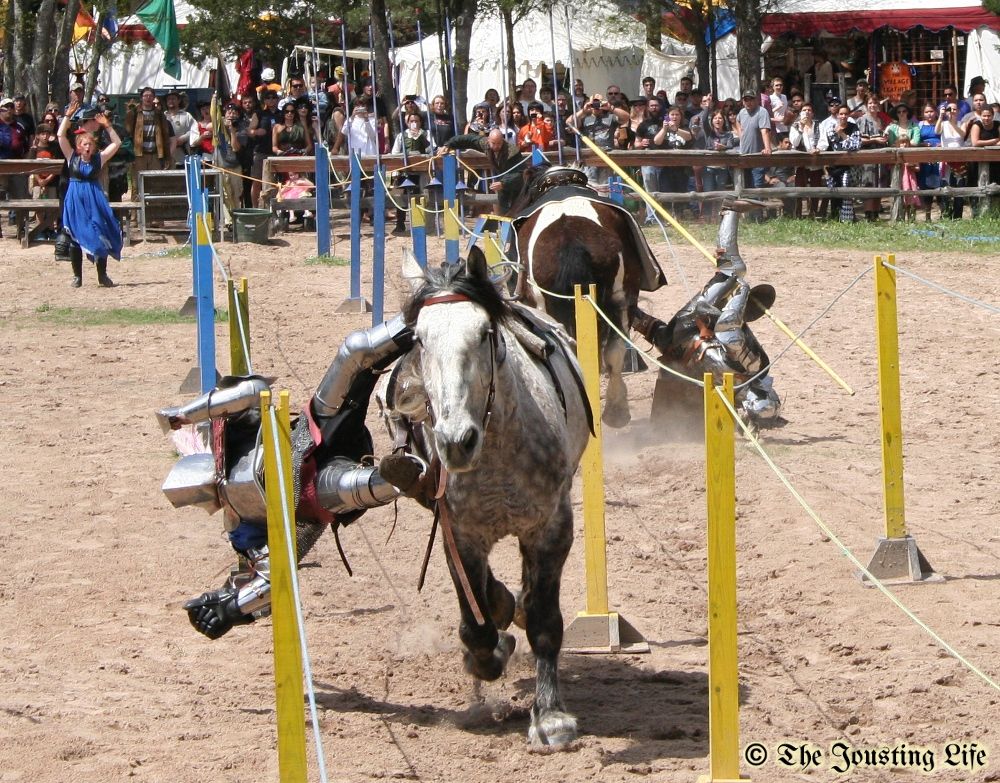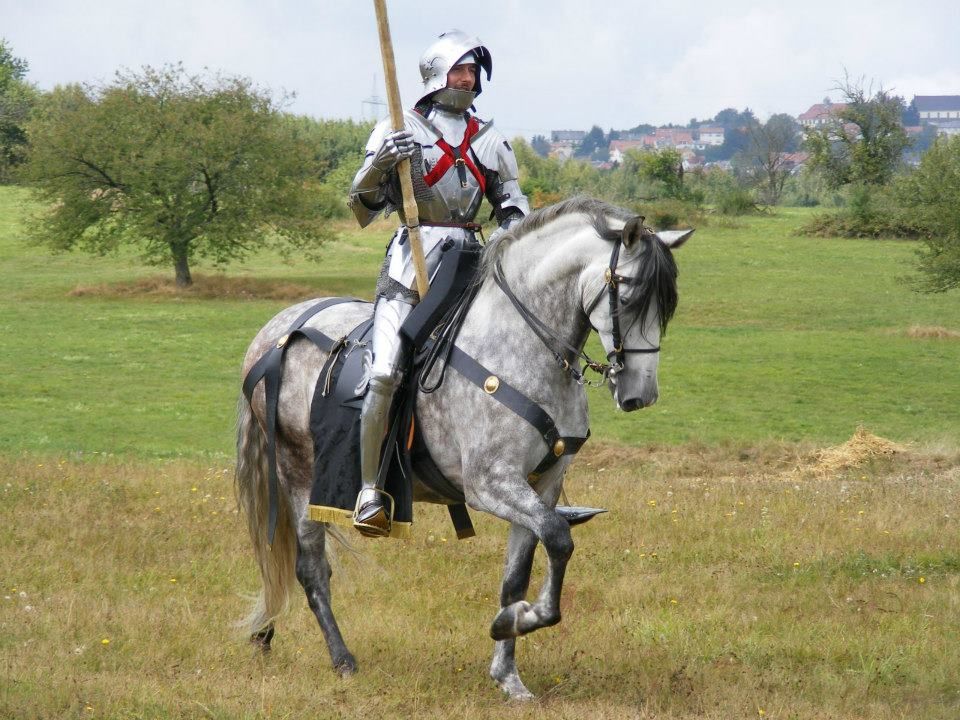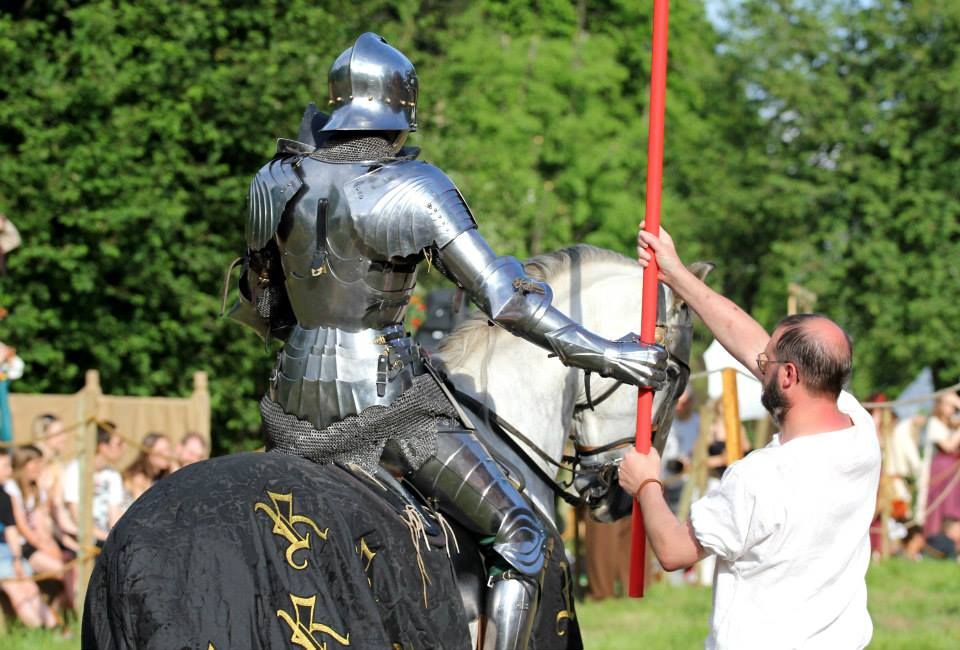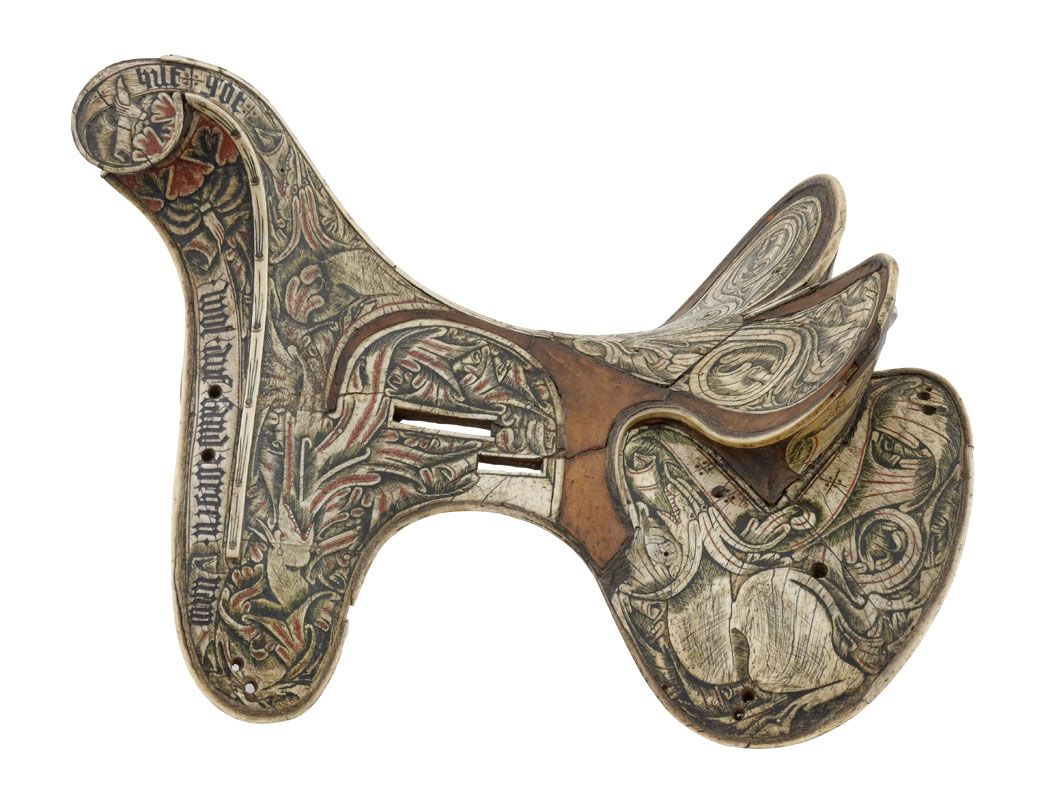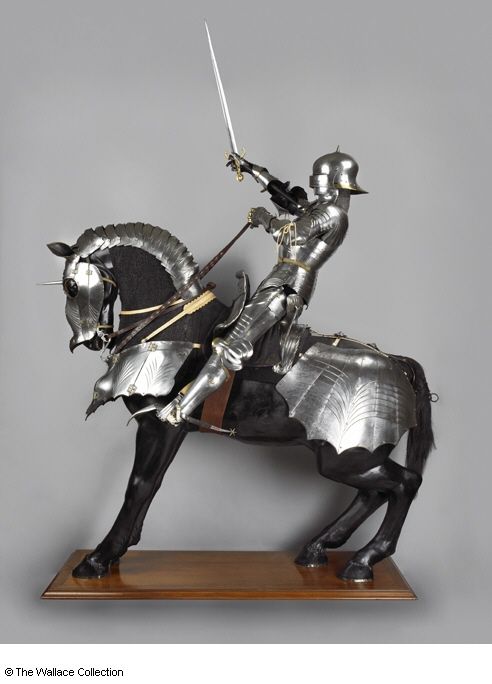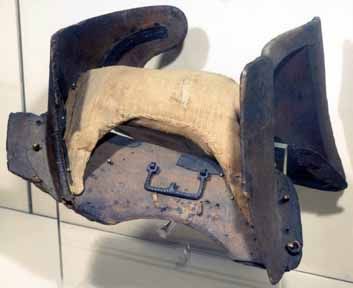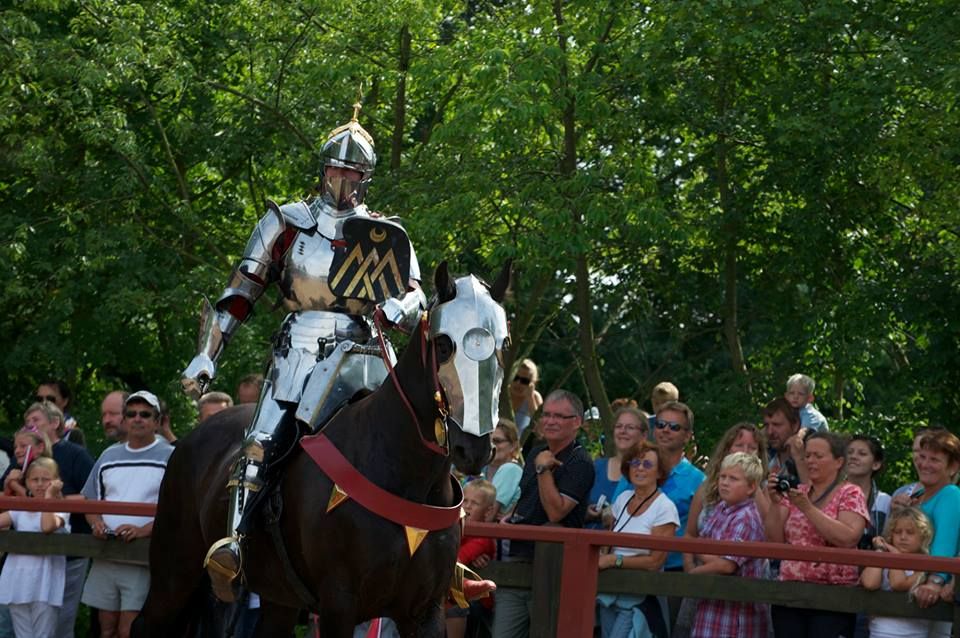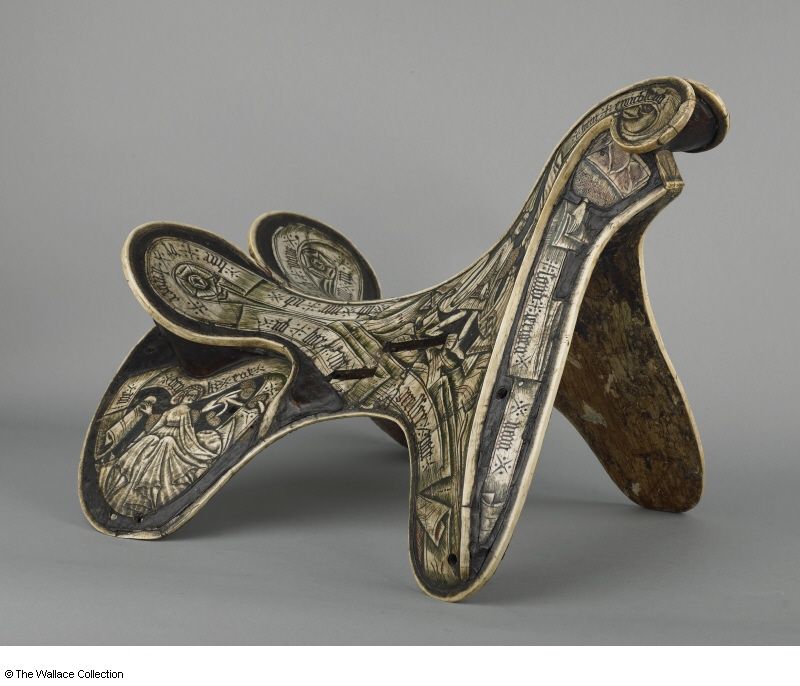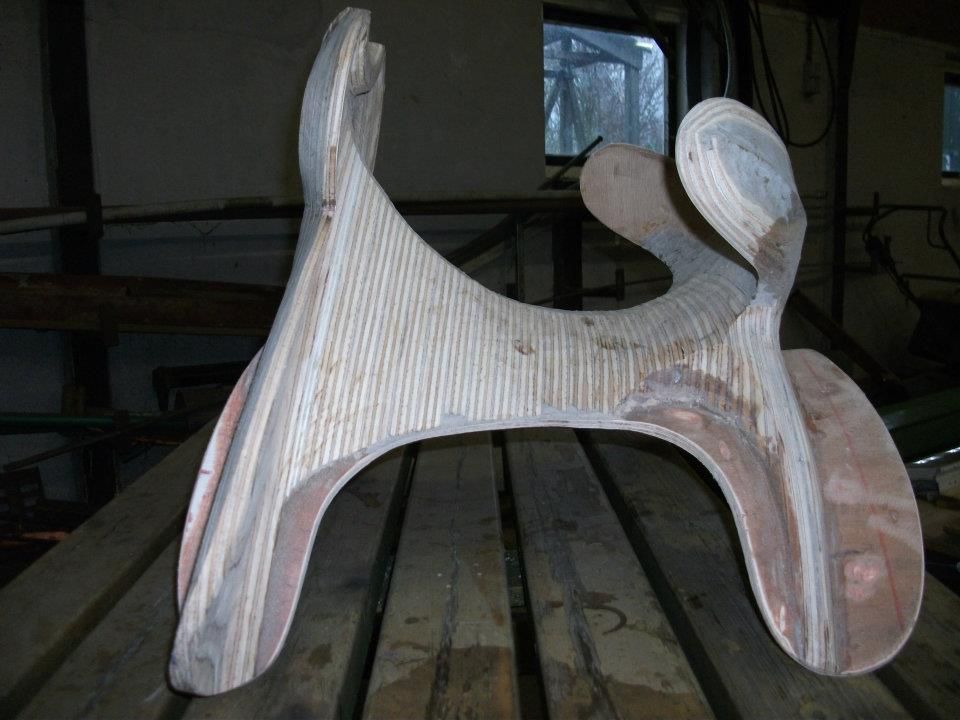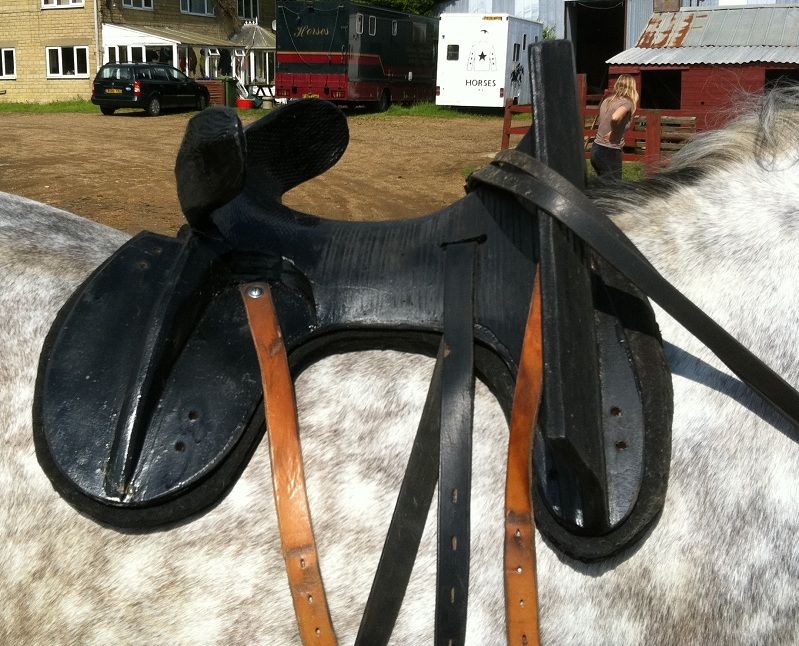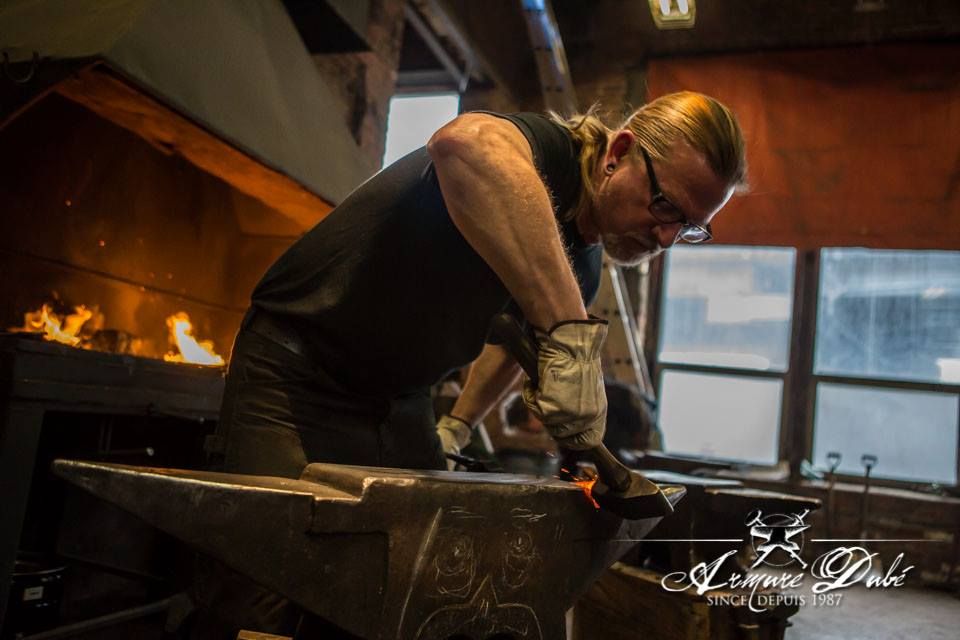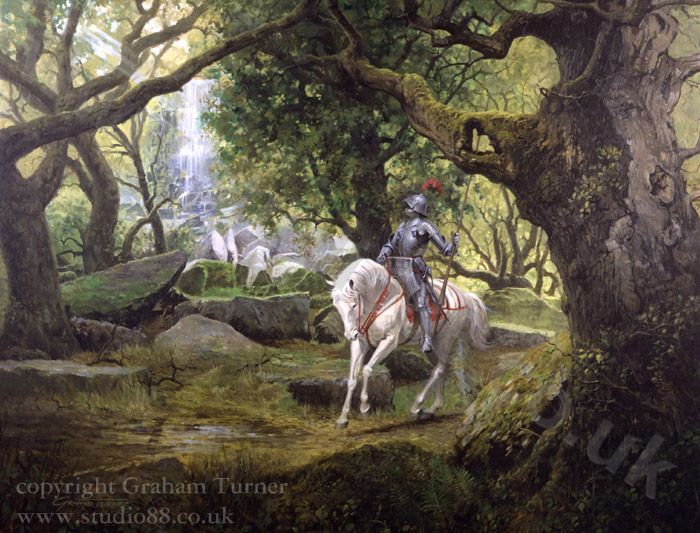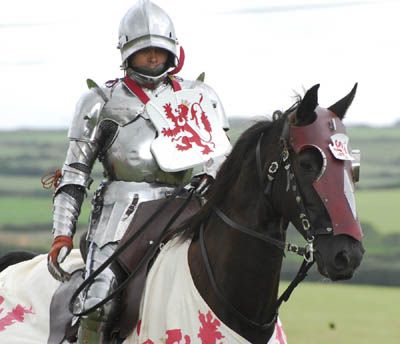This past Saturday and Sunday, March 29 & 30, were the last days of the 2014 Sherwood Forest Faire. As has become tradition, instead of the usual jousting show, the last weekend of faire featured a competitive jousting tournament. Seven jousters participated this year, including jousters from the New Riders of the Golden Age, the Knights of Mayhem, the Knights of Valour and others. David Schade, the leader of the New Riders of the Golden Age, was the winner of this year's jousting tournament. Because he had been performing as Sir William Dudley during the run of the faire, he was referred to as Sir William during the competition as well.
On the last day of the tournament, David Schade came into the final session of jousting having lost not a single match. Both Charlie Andrews and Eddie Rigney entered the final session with a single loss each. So Charlie and Eddie faced off in the first match of the session to see who would advance to compete with David for tournament champion. During the second pass Charlie's lance positively disintegrated from the power of his strike, and after five passes, Charlie had won the match and the chance to advance.
Charlie Andrews shatters his lance against Eddie Rigney(video by The Jousting Life)
The final match between Charlie and David was very evenly matched. Only the first pass did not include a lance break, though both competitors struck their opponent fairly. In the second pass, both competitors broke their lances against one another. In the third pass, Charlie broke his lance, and in the fourth and fifth pass, David broke his. A sixth pass was run, and both competitors again broke both their lances. At the end of the match, David was the winner of the match by one lance break and was declared the Champion of the Sherwood Forest Faire Jousting Tournament.
You can see video of all six passes on The Jousting Life YouTube Channel, but here is the jousting pass that put David Schade in the lead and eventually led to his winning the tournament:
David Schade breaks his lance and Charlie doesn't during the fifth pass of the final match
(video by The Jousting Life)
David rode a Clydesdale mare named Christine throughout the tournament. Christine is 18 hands tall, 19 years old and has been jousting with the New Riders of the Golden Age for 10 years. Below, David poses with Christine while wearing the sash he was awarded for winning the tournament and gives her a kiss in appreciation for her partnership in the joust.(In case you are wondering, the sash reads,"Joust Master of the Universe.")
[EDIT 4-1-14: David sent me a message about the sash: "I feel like I should point out that the sash was made by some of my teammates as a joke. Which I wore proudly. It wasn't actually awarded for winning." -- David Schade]
Coming in second by a single lance break was Charlie Andrews, leader of the Knights of Mayhem. Charlie is probably best known from the National Geographic tv series, "Knights of Mayhem" which followed him the other members of his jousting troupe to several tournaments. However, Charlie has also been featured in a number of articles on The Jousting Life.
Charlie's horse Jaegermeister is a fan favorite. He even had his own cheering section who frequently chanted his name throughout the tournament. Jaegermeister is 13 year old, 16.3 hand, Belgian gelding.
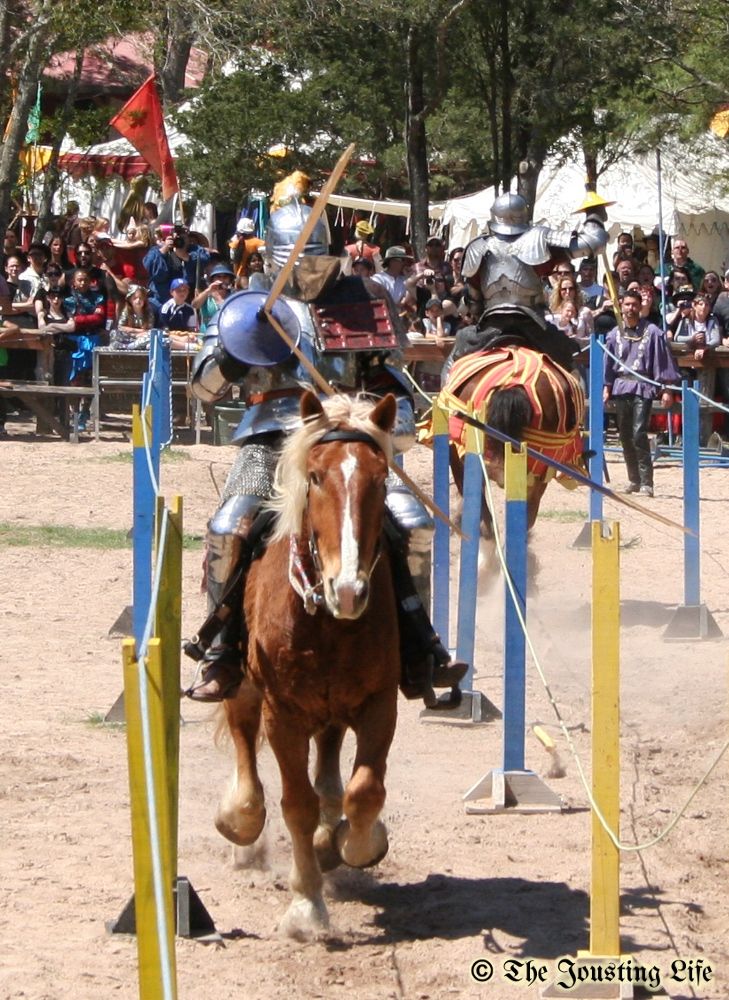
Jaegermeister carries Charlie Andrews down the list after a massive double lance break against David Schade(photo by The Jousting Life)
Eddie Rigney of the Knights of Valour came in third. Eddie always wears pink in some form when he jousts in honor of his mother and others who are fighting breast cancer. Eddie's jousting career is currently sponsored by Palmetto Moonshine, Fish Stalker Lures and Monster Energy Drink. You can read more about Eddie in this article about him.
Eddie could not bring a horse of his own, so Charlie Andrews graciously allowed Eddie to ride Arthur, one of the Knights of Mayhem's horses. Arthur is a 12 year old, 17.1 hand, Percheron gelding.

Arthur charges down the tilt, carrying Eddie in a match against David Schade on Christine
(photo by The Jousting Life)
Two other competitors made it all the way through the tournament, Joshua Warren of the Knights of Mayhem and Ryan Scammon of the New Riders of the Golden Age. Joshua rode Thor, a 10 year old, 17 hand, Paint/Belgian cross gelding. Ryan rode Marcus, a 20 year old, 18 hand, Percheron gelding.


Joshua Warren(left) and Ryan Scammon(right)(photos by Pamela Morgan)
Joshua Warren is unhorsed by David Schade(video by The Jousting Life)
Ryan Scammon is unhorsed by Charlie Andrews(video by The Jousting Life)
Unfortunately, two other competitors were unable to complete the tournament, James Johnson and Elizabeth Jones. Although James Johnson was still recovering from surgery on his left shoulder performed just 7 weeks earlier where he had to have several tendons re-attached and 5 screws implanted, he was determined to joust at Sherwood. Unfortunately, after the dramatic double unhorsing during the 2pm session the first day of the tournament, he not only aggravated his shoulder, but also damaged his hand and was unable to continue to compete. (You can see a picture and video of this pass in a previous article.) Even though he was in pain from his injuries and disappointed at having to withdraw from the tournament, he still wanted to express how grateful he was to Charlie Andrews for mentoring him in the sport of competitive jousting.
Elizabeth Jones also had to limit her jousting during the competition. She had injured her back during a practice session a couple of weeks before, and when she and Ryan Scammon knocked each other off their horses during the noon session of jousting on the first day of the tournament, she aggravated her previous injury and decided to sit out the rest of that day's jousting. On the second day of the tournament, she again rode only in the noon session of jousting. [Unfortunately, due to illness, I missed both noon sessions of the tournament and did not get any pictures or video of Elizabeth jousting.]
The Sherwood Forest Faire Jousting Tournament continues to be quite popular. The stands were packed for both days of the tournament, and the audience was loudly enthusiastic. You can find out more about the faire and their jousting tournament on the Sherwood Forest Faire website and Facebook page. And don't forget to 'like' The Jousting Life Facebook page in order to keep up with the latest news, pictures and videos.
On the last day of the tournament, David Schade came into the final session of jousting having lost not a single match. Both Charlie Andrews and Eddie Rigney entered the final session with a single loss each. So Charlie and Eddie faced off in the first match of the session to see who would advance to compete with David for tournament champion. During the second pass Charlie's lance positively disintegrated from the power of his strike, and after five passes, Charlie had won the match and the chance to advance.
Charlie Andrews shatters his lance against Eddie Rigney(video by The Jousting Life)
The final match between Charlie and David was very evenly matched. Only the first pass did not include a lance break, though both competitors struck their opponent fairly. In the second pass, both competitors broke their lances against one another. In the third pass, Charlie broke his lance, and in the fourth and fifth pass, David broke his. A sixth pass was run, and both competitors again broke both their lances. At the end of the match, David was the winner of the match by one lance break and was declared the Champion of the Sherwood Forest Faire Jousting Tournament.
You can see video of all six passes on The Jousting Life YouTube Channel, but here is the jousting pass that put David Schade in the lead and eventually led to his winning the tournament:
David Schade breaks his lance and Charlie doesn't during the fifth pass of the final match
(video by The Jousting Life)
David rode a Clydesdale mare named Christine throughout the tournament. Christine is 18 hands tall, 19 years old and has been jousting with the New Riders of the Golden Age for 10 years. Below, David poses with Christine while wearing the sash he was awarded for winning the tournament and gives her a kiss in appreciation for her partnership in the joust.(In case you are wondering, the sash reads,"Joust Master of the Universe.")
[EDIT 4-1-14: David sent me a message about the sash: "I feel like I should point out that the sash was made by some of my teammates as a joke. Which I wore proudly. It wasn't actually awarded for winning." -- David Schade]
Coming in second by a single lance break was Charlie Andrews, leader of the Knights of Mayhem. Charlie is probably best known from the National Geographic tv series, "Knights of Mayhem" which followed him the other members of his jousting troupe to several tournaments. However, Charlie has also been featured in a number of articles on The Jousting Life.
Charlie's horse Jaegermeister is a fan favorite. He even had his own cheering section who frequently chanted his name throughout the tournament. Jaegermeister is 13 year old, 16.3 hand, Belgian gelding.

Jaegermeister carries Charlie Andrews down the list after a massive double lance break against David Schade(photo by The Jousting Life)
Eddie Rigney of the Knights of Valour came in third. Eddie always wears pink in some form when he jousts in honor of his mother and others who are fighting breast cancer. Eddie's jousting career is currently sponsored by Palmetto Moonshine, Fish Stalker Lures and Monster Energy Drink. You can read more about Eddie in this article about him.
Eddie could not bring a horse of his own, so Charlie Andrews graciously allowed Eddie to ride Arthur, one of the Knights of Mayhem's horses. Arthur is a 12 year old, 17.1 hand, Percheron gelding.

Arthur charges down the tilt, carrying Eddie in a match against David Schade on Christine
(photo by The Jousting Life)
Two other competitors made it all the way through the tournament, Joshua Warren of the Knights of Mayhem and Ryan Scammon of the New Riders of the Golden Age. Joshua rode Thor, a 10 year old, 17 hand, Paint/Belgian cross gelding. Ryan rode Marcus, a 20 year old, 18 hand, Percheron gelding.


Joshua Warren(left) and Ryan Scammon(right)(photos by Pamela Morgan)
Joshua Warren is unhorsed by David Schade(video by The Jousting Life)
Ryan Scammon is unhorsed by Charlie Andrews(video by The Jousting Life)
Unfortunately, two other competitors were unable to complete the tournament, James Johnson and Elizabeth Jones. Although James Johnson was still recovering from surgery on his left shoulder performed just 7 weeks earlier where he had to have several tendons re-attached and 5 screws implanted, he was determined to joust at Sherwood. Unfortunately, after the dramatic double unhorsing during the 2pm session the first day of the tournament, he not only aggravated his shoulder, but also damaged his hand and was unable to continue to compete. (You can see a picture and video of this pass in a previous article.) Even though he was in pain from his injuries and disappointed at having to withdraw from the tournament, he still wanted to express how grateful he was to Charlie Andrews for mentoring him in the sport of competitive jousting.
Elizabeth Jones also had to limit her jousting during the competition. She had injured her back during a practice session a couple of weeks before, and when she and Ryan Scammon knocked each other off their horses during the noon session of jousting on the first day of the tournament, she aggravated her previous injury and decided to sit out the rest of that day's jousting. On the second day of the tournament, she again rode only in the noon session of jousting. [Unfortunately, due to illness, I missed both noon sessions of the tournament and did not get any pictures or video of Elizabeth jousting.]
The Sherwood Forest Faire Jousting Tournament continues to be quite popular. The stands were packed for both days of the tournament, and the audience was loudly enthusiastic. You can find out more about the faire and their jousting tournament on the Sherwood Forest Faire website and Facebook page. And don't forget to 'like' The Jousting Life Facebook page in order to keep up with the latest news, pictures and videos.

